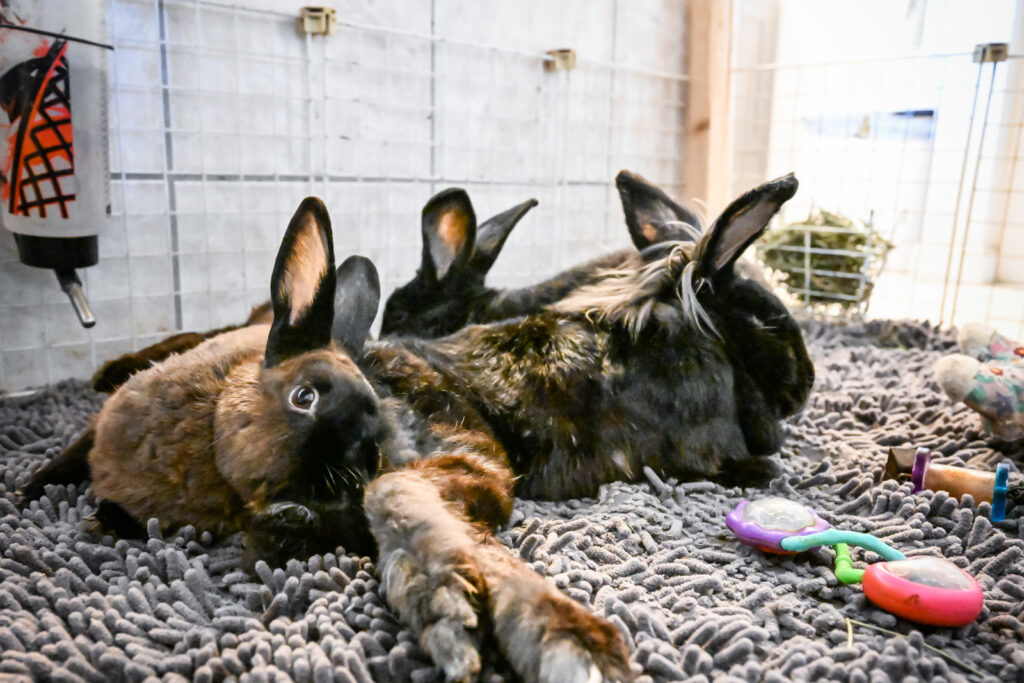Bunnies with the best intentions may not always be physically able to comply with our litterbox demands. If your bunny has a crippling disease or geriatric aches and pains that make him unable to use his box, do you shut him away in his cage for the rest of his life? With only minor adjustments, you have a much better option than that.
ADJUST THE BOX
The litterbox might be too high to scale. Replace it with a large haytub with a cutaway door that has a one-inch threshold. This allows a crippled or stiff-jointed elderly rabbit to access the inside. Why a tub instead of a litterbox? Because impaired bunnies cannot maneuver a turn-around inside a small box.
ADJUST THE ENVIRONMENT
Even a one inch threshold is too high for some rabbits. A flat area is needed that has no barriers to cross, that can be urinated on, that absorbs moisture, and that won’t scatter. And you need protection for your floor. This is all accomplished with a washable/disposable rug on top of newspapers on top of a tray.
1. Top layer
a) The washable rug: I use the largest (30¬ x 40¬) synthetic fleece rugs that fit in my washer (two at a time). This size also stays in place as bunnies crawl or scoot over it. Synthetic fleece provides cushioning for not-so-upright bunnies whose bodies keep contact with the surface. (Use diapers if there’s urine burn.)
b) The disposable rug: For partially crippled rabbits who can sit upright, this “rug” is the same seagrass matting often listed under chew-toys for bunnies. Instead of being washed, the soiled matting can be disposed of (or composted). It’s not as expensive a solution as it seems. The matting can be rotated several times, allowing wet areas to dry out. And most of the moisture passes through the rug, so if the absorbent material underneath is changed daily, the matting itself can last a month.
2. Middle Layer
Absorbent material: When used on a flat surface, instead of in a deep box, this material also has to be flat. Newspapers, magazines, junk mail, paper towels, and pages from old phone directories supply this layer, which is placed underneath the washable or disposable rug.
3. Bottom Layer
The flat tray: Oil-drip pans with smooth rounded edges (no sharp, potentially dangerous corners) are available in auto supply and hardware stores everywhere. They come in a variety of sizes. I use the 24¬x 36¬and 24¬ x 48¬, with seagrass matting cut to the same size. Two trays, side-by-side, can cover an even larger area. The shallow “lip” all around the tray is just enough to hold the matting in place. If you have multiple rabbits of varying degrees of mobility, you won’t want to replace the litterbox but the rug-tray arrangement can be added to the litterbox corner for those who “go beside the box instead of in it.”For this arrangement to work, you must have all three layers. The rug or matting on top, which allows moisture to drain through, an absorbent layer in the middle to soak up moisture, and a waterproof layer on the bottom to prevent moisture from reaching your floor or furnishings.
I have lived with over [70] disabled rabbits during the past [40] years, and this is by far the best solution I have found. It provides quality of life for disabled bunnies and sanity for human caregivers.
©Copyright Marinell Harriman. All Rights Reserved. Republished with the permission of the author.
Litter Training: for those who want to but can’t was originally published in House Rabbit Journal Volume III, Number 12

